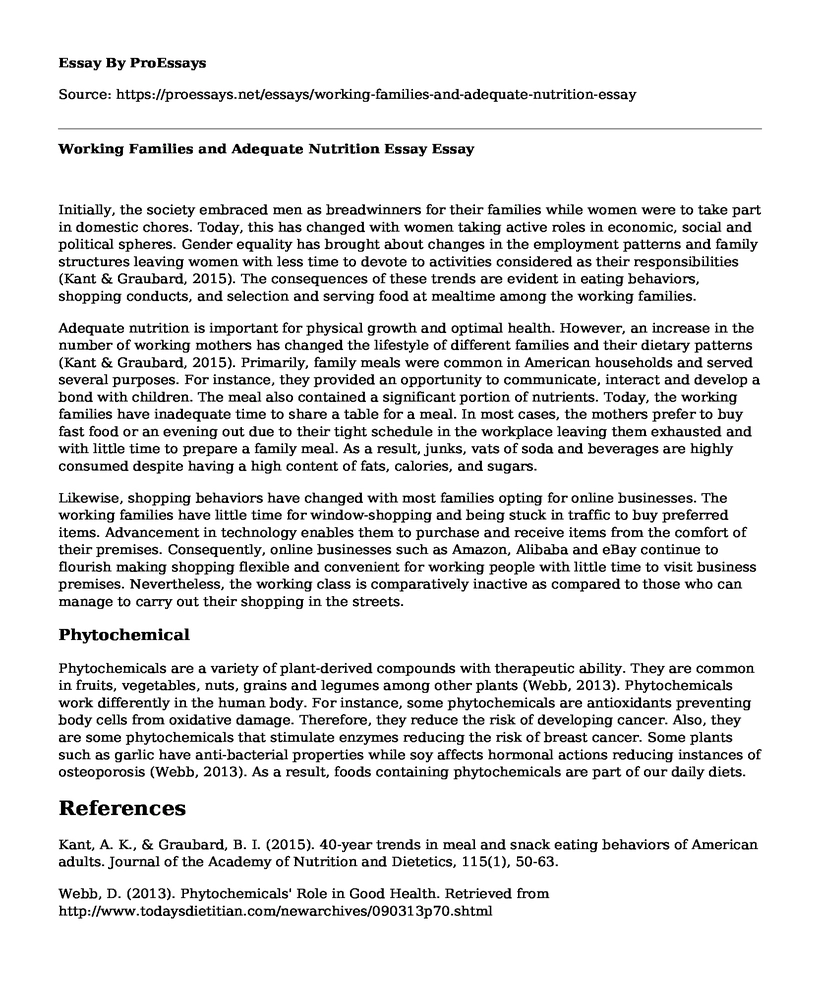Initially, the society embraced men as breadwinners for their families while women were to take part in domestic chores. Today, this has changed with women taking active roles in economic, social and political spheres. Gender equality has brought about changes in the employment patterns and family structures leaving women with less time to devote to activities considered as their responsibilities (Kant & Graubard, 2015). The consequences of these trends are evident in eating behaviors, shopping conducts, and selection and serving food at mealtime among the working families.
Adequate nutrition is important for physical growth and optimal health. However, an increase in the number of working mothers has changed the lifestyle of different families and their dietary patterns (Kant & Graubard, 2015). Primarily, family meals were common in American households and served several purposes. For instance, they provided an opportunity to communicate, interact and develop a bond with children. The meal also contained a significant portion of nutrients. Today, the working families have inadequate time to share a table for a meal. In most cases, the mothers prefer to buy fast food or an evening out due to their tight schedule in the workplace leaving them exhausted and with little time to prepare a family meal. As a result, junks, vats of soda and beverages are highly consumed despite having a high content of fats, calories, and sugars.
Likewise, shopping behaviors have changed with most families opting for online businesses. The working families have little time for window-shopping and being stuck in traffic to buy preferred items. Advancement in technology enables them to purchase and receive items from the comfort of their premises. Consequently, online businesses such as Amazon, Alibaba and eBay continue to flourish making shopping flexible and convenient for working people with little time to visit business premises. Nevertheless, the working class is comparatively inactive as compared to those who can manage to carry out their shopping in the streets.
Phytochemical
Phytochemicals are a variety of plant-derived compounds with therapeutic ability. They are common in fruits, vegetables, nuts, grains and legumes among other plants (Webb, 2013). Phytochemicals work differently in the human body. For instance, some phytochemicals are antioxidants preventing body cells from oxidative damage. Therefore, they reduce the risk of developing cancer. Also, they are some phytochemicals that stimulate enzymes reducing the risk of breast cancer. Some plants such as garlic have anti-bacterial properties while soy affects hormonal actions reducing instances of osteoporosis (Webb, 2013). As a result, foods containing phytochemicals are part of our daily diets.
References
Kant, A. K., & Graubard, B. I. (2015). 40-year trends in meal and snack eating behaviors of American adults. Journal of the Academy of Nutrition and Dietetics, 115(1), 50-63.
Webb, D. (2013). Phytochemicals' Role in Good Health. Retrieved from http://www.todaysdietitian.com/newarchives/090313p70.shtml
Cite this page
Working Families and Adequate Nutrition Essay. (2022, Jun 22). Retrieved from https://proessays.net/essays/working-families-and-adequate-nutrition-essay
If you are the original author of this essay and no longer wish to have it published on the ProEssays website, please click below to request its removal:
- Research Paper on Social Entrepreneurship
- The Coronary Artery Disease Paper Example
- Essay Sample on Future Development of Nursing
- Paper Sample on Human Body: Hormones Essential for Reproduction & Functioning
- Rituals for Strengthening Friendships: Achieving Common Goals Together - Essay Sample
- Essay Example on The Industrial Revolution: Transforming US Economy and Society
- Essay Sample on The Buffalo Crime Family: Pursuing the American Dream Through Deviance







